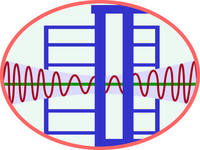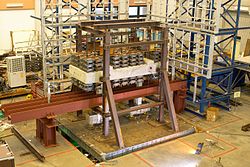- National Center for Research on Earthquake Engineering
-
NCREE 
Type: Non-Profit Organisation Established: 1980 Director: Tsai, Keh-Chyuan (蔡克銓) Faculty: 100 Address: No.200, Section 3, Xinhai Rd, Taipei 106, Taiwan
Tel: +886-2-6630-0888 E-mail: admin@ncree.org.tw Website: http://w3.ncree.org/ National Center for Research on Earthquake Engineering (NCREE) (國家地震工程研究中心) is an organisation found in Taipei, Taiwan. Since Taiwan is located on the ridge of the Eurasian and Philippine tectonic plates, it is highly seismic. The biggest earthquake in Taiwan in more than a century was 21 September 1999, also known as the Chi-Chi earthquake which measured 7.3 on the Richter scale.
NCREE was established in 1980 by the National Science Council (NSC), and they are working together with the National Taiwan University (NTU), as well as being part of the National Applied Research Laboratories (NARL, a non-profit organisation established in June 2003), whose purpose to improve efficiency between research institutions, and they are trying to decrease the impact of earthquakes on various structures.
They have published books and printed reports with all their findings. This is to try raise public awareness. They also hold international seminars, make videos, and hold a design construction competition every year.
Contents
Aims
NCREE is aiming to improve seismic resistant designs for all constructions and to provide feedback to the engineering community through research and development. The Center was built for researchers to collaborate and check their theories by doing various experiments. Their goals are:
- Establish and provide research facilities.
- Develop and improve the seismic engineering database.
- Create and carry-out regulations relating to seismic design codes.
- Co-ordinate and Integrate academic institutes and related industries.
- Introduce, Develop and Educate on seismic-resisting technology.
Facilities
NCREE's seismic stimulation laboratory has international standard facilities, such as eighteen sets of static hydraulic actuators and six sets of dynamic hydraulic actuators.
Seismic Stimulation Shaking Table
The Tri-Axial Seismic Stimulator, or Shaking Table, can produce earthquake ground motions in six degrees of freedom, with motion in 3 axes.
The shaking table is 5m x 5m and has a mass of 27 tons. It can take models of large scale buildings weighing up to 50 tons, and the square shape of the table provides large bending and torsional stiffness.
Small-scale or full-scale models are placed on the shaking table. To prevent the instrument vibration on surrounding areas during experiments, the shaking table has a vibration isolation system, including 80 dampers, 96 airbags and air springs, and a reaction mass (16m x 16m x 7.6m, weighing about four thousand tons.)
Under the table are twelve actuators, which produce the shaking movement in six degrees of freedom. There are four actuators for each axis, and the hydraulic power is provided by two electrical pumps and three diesel pumps. The weight of the shaky table and the model is balanced by four static supports.
By doing these experiments, engineers can understand a structure's response to an earthquake. The results will show how stable the building is during earthquakes, and it will also accelerate the development of seismic isolation and minimize the damage caused by an earthquake.
Reaction Wall and Strong Floor
The Reaction Wall and Strong floor make it possible to test multiple full-scale structural experiments. The wall can be used to perform seismic tests by using experimental methods, such as traditional quasi-static tests, cyclic loading tests and pseudo-dynamic tests.
The wall is L-shaped and has 4 sections: 15m x 15.5m, 12m x 15.5m, 9m x 12m and 6m x 12m. The strong floor is a reinforced block of concrete 60m x 29m x 1.2m. The compressive strength of the concrete for both the reaction wall and the strong floor is 350 kg/cm2
During experiments, full-scale and large-scale constructions are mounted onto the strong floor. Hydraulic actuators then exert forces on the test objects, making it possible to see the resistance of various structures and performances of seismic isolators and energy dissipaters. The experimental data has helped proved that seismic theories can be applied, and are a reference to earthquake resistant building designs.
Research Activities
Building Engineering Studies
- Seismic evaluation and retrofit technologies of existing buildings.
- Development of advanced innovative construction.
- Revision of building seismic design codes.
Bridge Engineering Studies
- performance-based design of bearing systs in bridges.
- Seismic evaluation and retrofit technologies of existing bridges.
Structural Control and System Identification Studies
- Studies on structural health monitoring and structural control.
- Seismic evaluation and retrofit technologies for high-tech industrial structures.
Geotechnical and Strong Ground Motion Studies
- Studies on earthquake prediction models.
- Establishment of geological databases for strong motion stations of the Central Weather Bureau (CWB).
- Seismic behaviour of the investigation of soils in the large bi-axial shaking table shear box.
Earthquake Scenario Studies
- Establishment and application of geotechnical earth science hazard database.
- Development of Taiwan seismic scenario database and its applications.
- Development of Taiwan Earthquake Loss Estimation System.
Experimental Technology Studies
- Collaborative experiment technology using the Internet.
- Application of optical fiber sensors in civil engineering structures.
Information Technology Studies
- Establishment of an earthquake engineering database.
- Integration of numerical and experimental stimulation.
Educating
To educate people about earthquakes, there are published books, printed reports, international seminars and videos. NCREE also holds IDEERS and ITP to raise public awareness.
IDEERS
IDEERS stands for "Introducing and Demonstrating Earthquake Engineering Research in Schools" and is held every year by the British council in Taipei, NCREE and the Bristol University. It is a science-based project with a competition developed by the Earthquake Engineering Research Centre of the Bristol University. The students participating are undergraduate students majoring in civil engineering related subjects and high school students. Students entering the competition will make their models using cheap materials which then will be put on the tri-axial seismic simulator (shaking-table). Models will be shaken to destruction, and the best-designed models will win prizes.
ITP
ITP stands for The International Training Program (for Seismic Design of Structures and Hazard Mitigation) and is held by The National Science Council (NSC) and the Democratic Pacific Union. It is a short-term workshop to train government officials and engineers from different countries (In 2006, thirty-three people attended from fourteen different countries). The Program will try to improve the disaster-preventing technology and the earthquake-resisting ability of those countries and try reduce the impacts and losses caused by major earthquakes.
Gallery
See also
- Earthquake Engineering Research Institute
- International Institute of Earthquake Engineering and Seismology
References
1. NCREE's Official English Website Retrieved on 14-01-2008
2. NCREE homepage Retrieved on 14-01-2008
3. NCREE's Official Chinese Homepage Retrieved on 14-01-2008
4. 國家地震工程研究中心簡介影片 (National Center for Research on Earthquake Engineering explanation video)
5. NARL and NCREE information leaflet.
6. IDEERS Retrieved on 15-01-2008
7. ITP Retrieved on 15-01-2008
8. Bristol University IDEERS Retrieved on 15-01-2008
Earthquakes in Taiwan Earthquakes 1904 Douliu · 1906 Meishan · 1916-17 Nantou · 1935 Hsinchu-Taichung · 1941 Chungpu · 1946 Hsinhua · 1951 East Rift Valley · 1959 Hengchun · 1964 Baihe · 1966 Hualien · 1972 Ruisui · 1994 Taiwan Strait · 1999 Jiji ("921") · 2006 Hengchun · 2009 Hualien · 2010 KaohsiungOrganisations Central Weather Bureau · National Center for Research on Earthquake EngineeringCategories:- Earthquakes in Taiwan
- Research institutes in Taiwan
- Engineering research institutes
- Non-profit organizations based in Taiwan
- Earthquake engineering
Wikimedia Foundation. 2010.










